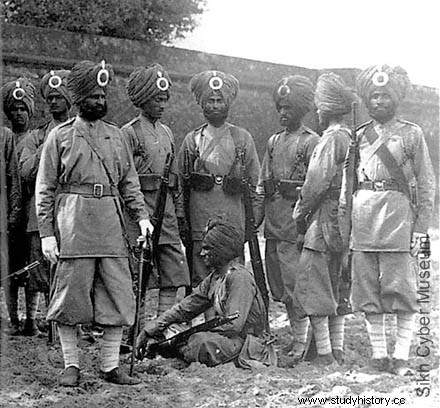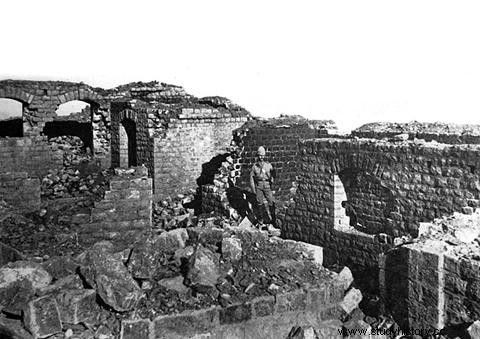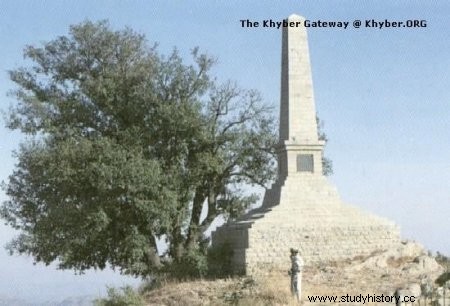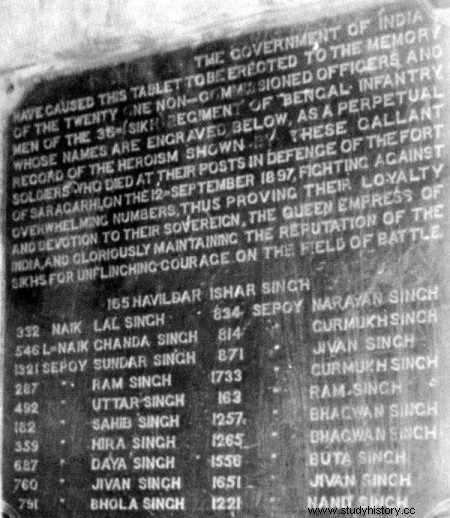We all know the feat of Thermopylae where Leonidas and his 300 Spartans of his – in addition to the 700 Thespians and 400 Thebans forgotten – they faced the innumerable army of Xerxes - innumerable because the numbers range from 100,000 to a million - but there was another similar feat that took place in what is now the territory of Pakistan where 21 Sikhs they faced 10,000 Pashtuns.
From the purely commercial beginnings of the British East India Company , passed to civil and military control of the territories in which it is established:India, Burma, Singapore, Pakistan... It even had a powerful army made up of 40,000 British and 200,000 sepoys (local Hindu and Muslim soldiers), with the power to declare war. As if this economic plundering were not enough, the "Doctrine of Lapse was applied “, whereby those territories whose regent died without a male heir passed into the control of the British Company. But after the Sepoy Rebellion (1857-1858) everything fell apart:all the holdings of the British East India Company passed into the hands of the British Crown.

Sikhs of the British Indian Army
To put down this rebellion, the British pulled the manual of "brutal repression » and, in addition, they were lucky to have the support of the Sikhs that although in the forties they had faced the British in the so-called Anglo-Sikh wars, they were still more resentful of the contempt of Hindus and Muslims. That show of loyalty served so that the Sikh Regiment gain prestige and recognition within the British Indian Army and, in addition, certain privileges were recognized with respect to the rest of the native soldiers. Sikh regiments were used for internal security and border protection against the Pashtuns (today the border between Pakistan and Afghanistan). In August 1897, five companies of the 36th Regiment of Sikhs, under the command of Lieutenant Colonel John Haughton , were sent to stop Pashtun raids by establishing themselves in the fortifications of Fort Lockhart and Fort Gulistan . Although located a few kilometers apart, the orographic difficulties of the area prevented visibility from one to the other. So, halfway there, Saragarhi was established. , a tower with a small stone wall and some building that would serve as a communication center between the two by means of a heliograph (Signal system by reflecting the sun's rays in mirrors). The Saragarhi garrison was made up of 21 Sikhs under the command of Sergeant Ishar .

Heliograph
On September 3 and 9, 1897, thousands of Pashtun orakzai tribesmen and afridi They tried to storm Fort Gulistan but the British and Sikhs managed to hold out without much trouble. The Pashtuns were still in the area and a contingent of 10,000 went to Saragarhi to cut communication between the two fortifications so that they could not receive reinforcements. On September 12, and faced with the imminent threat, Havildar Ishar gathered all the men to inform them of their situation:10,000 enemies were heading towards them and John Haughton had told them that they could not send reinforcements. Knowing that they were going to die, no one protested or tried to flee . Despite the brutal numerical difference –500 to 1 – they repulsed the attacks one after another. During all this time, Gurmukh , the man in charge of the heliograph, was in contact with Fort Lockhart and Fort Gulistan communicating every detail. After seven hours of resisting, the Pashtuns managed to knock down part of the wall… the lack of ammunition did the rest. When only Gurmukh was left alive, he issued this statement:
This is my last message. I'm going to take my rifle...
According to Pashtun sources, it is said that at the cry of «Bole Así Nihal… Sat Sri Akal » (the Sikh war cry that could roughly be translated as «I will fulfill it... God is the ultimate truth «), Gurmukh killed more than 20 enemies before falling. Those 7 hours that they managed to hold out and the fact that they kept communications open allowed Fort Gulistan to receive reinforcements from Fort Lockhart and completely repel the attack. When the British managed to reach Saragarhi they found the bodies of the 21 Sikhs... and more than 500 Pashtuns .

Ruins of Saragarhi on September 14
All 21 Sikhs were awarded the Indian Order of Merit , the highest award given to a soldier of the British Indian Army for their courage and sacrifice. A monument to the bravery of the Sikhs was erected in that place, on which there is a plaque with the names of all the heroes. Furthermore, according to UNESCO, the battle at Saragarhi is one of the eight stories of humanity's greatest collective bravery. September 12 is a day of pride for Sikhs.


Sources:Devology, India Post, The Tribune India
